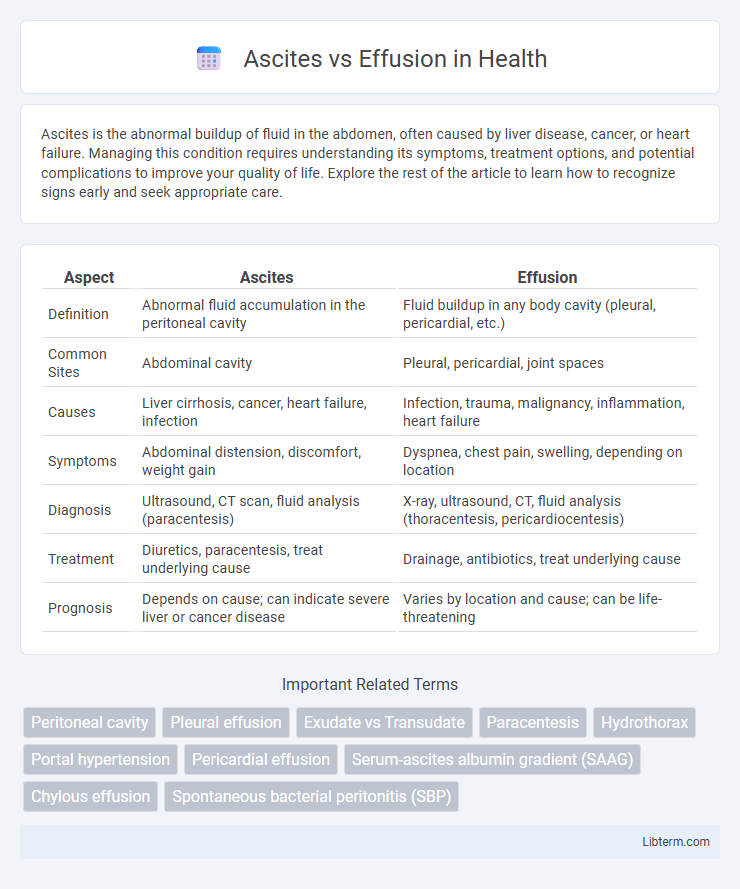Ascites is the abnormal buildup of fluid in the abdomen, often caused by liver disease, cancer, or heart failure. Managing this condition requires understanding its symptoms, treatment options, and potential complications to improve your quality of life. Explore the rest of the article to learn how to recognize signs early and seek appropriate care.
Table of Comparison
| Aspect | Ascites | Effusion |
|---|---|---|
| Definition | Abnormal fluid accumulation in the peritoneal cavity | Fluid buildup in any body cavity (pleural, pericardial, etc.) |
| Common Sites | Abdominal cavity | Pleural, pericardial, joint spaces |
| Causes | Liver cirrhosis, cancer, heart failure, infection | Infection, trauma, malignancy, inflammation, heart failure |
| Symptoms | Abdominal distension, discomfort, weight gain | Dyspnea, chest pain, swelling, depending on location |
| Diagnosis | Ultrasound, CT scan, fluid analysis (paracentesis) | X-ray, ultrasound, CT, fluid analysis (thoracentesis, pericardiocentesis) |
| Treatment | Diuretics, paracentesis, treat underlying cause | Drainage, antibiotics, treat underlying cause |
| Prognosis | Depends on cause; can indicate severe liver or cancer disease | Varies by location and cause; can be life-threatening |
Understanding Ascites and Effusion
Ascites refers to the pathological accumulation of fluid specifically within the peritoneal cavity, commonly caused by liver cirrhosis, malignancies, or heart failure. Effusion denotes fluid buildup in various body spaces such as the pleural cavity (pleural effusion), pericardium (pericardial effusion), or joints (synovial effusion), each presenting distinct clinical implications and treatment approaches. Differentiating ascites from other effusions relies on location, etiology, and diagnostic analysis like fluid sampling and imaging studies.
Key Differences Between Ascites and Effusion
Ascites refers specifically to the pathological accumulation of fluid within the peritoneal cavity often caused by conditions such as liver cirrhosis, heart failure, or cancer. Effusion is a broader term describing fluid buildup in any body cavity, including pleural, pericardial, or joint spaces, and is classified by its location and etiology. The key difference lies in ascites being a subset of effusion localized to the abdomen, whereas effusion encompasses diverse fluid collections that require tailored diagnostic and therapeutic approaches based on their anatomical site and underlying causes.
Causes of Ascites
Ascites primarily results from liver cirrhosis, which accounts for approximately 75% of cases due to portal hypertension and hypoalbuminemia. Other significant causes include malignancies, congestive heart failure, and infections such as tuberculosis peritonitis. Understanding these etiologies facilitates targeted diagnostic evaluation and effective management of ascitic fluid accumulation.
Causes of Effusion
Effusion is the abnormal accumulation of fluid in body cavities, primarily caused by inflammation, infection, malignancy, or trauma. Common causes include pleural effusion resulting from pneumonia, tuberculosis, or metastatic cancer, and pericardial effusion linked to pericarditis or malignancy. Understanding the etiology of effusion is crucial for distinguishing it from ascites, which specifically refers to fluid accumulation in the peritoneal cavity often caused by liver cirrhosis or heart failure.
Common Symptoms: Ascites vs Effusion
Ascites commonly presents with abdominal distension, discomfort, and weight gain due to fluid accumulation in the peritoneal cavity, while pleural effusion is characterized by chest pain, shortness of breath, and cough caused by fluid in the pleural space. Both conditions may lead to decreased mobility and respiratory difficulties; however, ascites predominantly affects the abdominal region whereas pleural effusion impacts lung function. Diagnostic imaging like ultrasound and chest X-ray are essential to differentiate between ascitic fluid and pleural effusion for targeted treatment.
Diagnostic Methods for Ascites and Effusion
Diagnostic methods for ascites primarily include abdominal ultrasound, which offers high sensitivity in detecting fluid accumulation in the peritoneal cavity, and paracentesis, enabling fluid analysis to determine the etiology such as infections, malignancy, or liver cirrhosis. For pleural effusion, chest X-rays and thoracic ultrasound are instrumental in visualizing fluid in the pleural space, with thoracentesis allowing sampling of pleural fluid to differentiate between transudate and exudate based on protein and lactate dehydrogenase levels, which is critical for diagnosing conditions like heart failure, pneumonia, or cancer. Advanced imaging techniques like CT scans can further delineate underlying causes and guide therapeutic interventions for both ascites and effusions.
Treatment Approaches for Ascites
Treatment approaches for ascites primarily involve sodium restriction and diuretic therapy, with spironolactone and furosemide commonly used to promote fluid excretion. In refractory cases, large-volume paracentesis is performed to remove excess fluid, often combined with albumin infusion to prevent circulatory dysfunction. Transjugular intrahepatic portosystemic shunt (TIPS) placement is considered for patients unresponsive to medical therapy, helping reduce portal hypertension and fluid accumulation.
Management of Effusion
Management of pleural effusion involves identifying the underlying cause, such as infection, malignancy, or heart failure, to tailor appropriate treatment. Therapeutic options include thoracentesis for symptomatic relief and diagnostic evaluation, chest tube insertion for continuous drainage, and pleurodesis to prevent recurrence in malignant cases. Advanced interventions like pleural decortication may be necessary for trapped lung or complicated effusions resistant to less invasive measures.
Complications Associated with Ascites and Effusion
Complications associated with ascites primarily include spontaneous bacterial peritonitis, hepatorenal syndrome, and respiratory distress due to increased abdominal pressure. Pleural effusions can lead to impaired gas exchange, respiratory failure, and infections like empyema. Both conditions may result in electrolyte imbalances and severe discomfort, necessitating timely intervention to prevent morbidity.
Preventive Strategies and Patient Care
Effective preventive strategies for ascites focus on managing underlying conditions such as liver cirrhosis, heart failure, and malignancies through regular monitoring, dietary sodium restriction, and appropriate diuretic therapy. In patient care for pleural effusion, timely thoracentesis, infection control, and addressing the primary cause are critical to prevent complications such as respiratory distress or infection. Both conditions benefit from individualized care plans that emphasize early detection, symptom management, and patient education to improve quality of life and reduce hospitalizations.
Ascites Infographic

 libterm.com
libterm.com